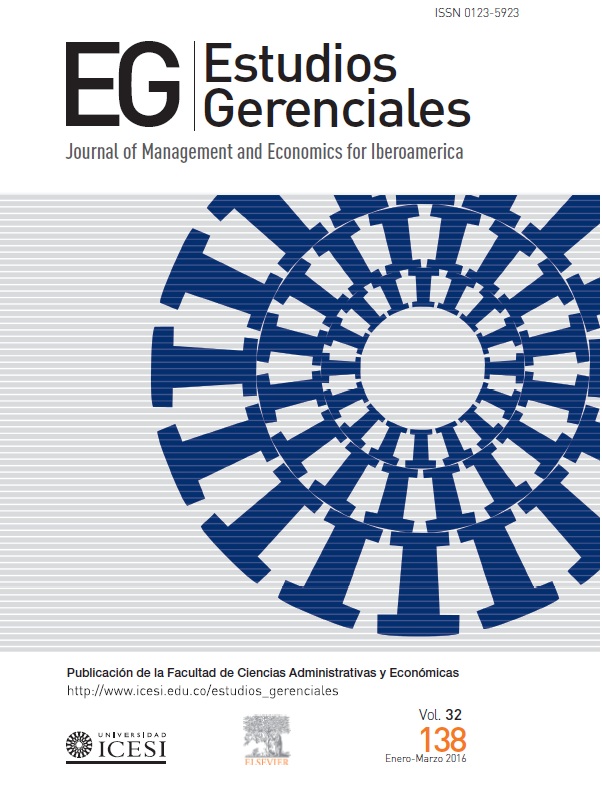Planeación por escenarios: un caso de estudio en una empresa de consultoría logística en Colombia
DOI:
https://doi.org/10.1016/j.estger.2015.12.004Palabras clave:
Planeación estratégica, Planeación de escenarios, Caso de estudio, Cadena de abastecimiento, Sector serviciosResumen
La incertidumbre sobre las tendencias del mercado y el entorno empresarial en el que se encuentran las compañías es uno de los principales retos que actualmente afrontan los directivos de las empresas. Una compañía que analiza su entorno e intenta predecir los posibles escenarios futuros no se verá sorprendida por los cambios del mismo y podrá establecer con anticipación planes de acción que le garanticen ser eficiente sin importar cuál de ellos se materialice. El presente artículo es un caso de estudio aplicado de planeación de escenarios en una compañía que ofrece el servicio de consultoría logística en Colombia. El resultado del proceso de planeación de escenarios permitió identificar importantes retos, tendencias y oportunidades de mercado para la compañía a objeto de estudio.
Descargas
Referencias
Bradfield, R., Wright, G., Burt, G., Cairns, G. y van der Heijden, K. (2005). The origins and evolution of scenario techniques in long range business planning. Futures, 37(8), 795–812.
Consumer Goods Forum (CGF) y Capgemini (2013). Future value chain: Industry Initiatives Address Challenges of the Digital World and the Fight for Resources. [consultado 10 Feb 2015]. Disponible en: https://www.capgemini.com/resource–file–access/resource/pdf/future_value_chain_2022_web.pdf
De Geus, A. P. (1988). Planning as learning. Harvard Business Review, 66(2), 70–74.
Fixler, D. J. y Siegel, D. (1999). Outsourcing and productivity growth in services. Structural Change and Economic Dynamics, 10(2), 177–194.
Glaister, K. W. y Falshaw, J. R. (1999). Strategic planning: Still going strong? Long Range Planning, 32(1), 107–116.
Johnston, R. y Clark, G. (2005). Service Operations Management: Improving Service Delivery (3th ed.). Boston, MA: Pearson Education.
Kaplan, R. S. y Norton, D. P. (1996). The Balanced Scorecard: Translating Strategy into Action. Boston, MA: Harvard Business Press.
Kathawala, Y. y Abdou, K. (2003). Supply chain evaluation in the service industry: A framework development compared to manufacturing. Managerial Auditing Journal, 18(2), 140–149.
Lapide, L. (2006). MIT's SC2020 project: The essence of excellence. Supply chain management review, 10(3), 18–24.
Lee, H. L. (2002). Aligning supply chain strategies with product uncertainties. California Management Review, 44(3), 105–119.
Mentzer, J. T., deWitt, W., Keebler, J. S., Min, S., Nix, N. W., Smith, C. D., et al. (2001). Defining supply chain management. Journal of Business Logistics, 22(2), 1–25.
Mintzberg, H. (1994). The Rise and Fall of Strategic Planning. Nueva York, NY: Simon and Schuster Inc.
Pearce, J. A., Freeman, E. B. y Robinson, R. B. (1987). The tenuous link between formal strategic planning and financial performance. Academy of Management Review, 12(4), 658–675.
Phadnis, S. S. (2012). Influencing managerial cognition and decisions using scenarios for long–range planning [tesis doctoral]. Cambridge, MA: Engineering Systems Division, Massachusetts Institute of Technology.
Porter, M. E. (1996). What is strategy? Harvard Business Review, 74(6), 61–78.
Quintero, J. S. (2003). Estrategia integral para pymes innovadoras. Revista EAN, (47), 34–45.
Sakhuja S., Jain V. (2012). Service Supply Chain: An Integrated Conceptual Framework: Proceedings of the 45th International Conference on Computers & Industrial Engineering, Cape Town, South Africa, 2012. CIE & SAIIE.
Schmenner, R. W. (1995). Service Operations Management. Londres: Prentice–Hall.
Schoemaker, P. J. (1993). Multiple scenario development: Its conceptual and behavioral foundation. Strategic Management Journal, 14(3), 193–213.
Schwartz, P. (1991). The Art of the Long View: Planning for the Future in an Uncertain World. Nueva York, NY: Doubleday.
Simchi–Levi, D., Kaminsky, P. y Simchi–Levi, E. (2008). Designing and Managing the Supply Chain (3th ed.). Nueva York, NY: McGraw–Hill/Irwin.
Sengupta S. (2013). 10 Supply Chain Trends for the Next 10 Years [consultado 10 Abr 2015]. Disponible en: http://www.supplychain247.com/article/10_supply_chain_trends_for_the_next_10_years/EVM_Partners/D4.
Van der Heijden, K. (2005). Scenarios: The Art of Strategic Conversation (2nd ed.). Nueva York, NY: John Wiley & Sons.
Von der Gracht, H. y Darkow, I. (2013). The future role of logistics for global wealthscenarios and discontinuities until 2025. Foresight, 15(5), 405–419.
Voudouris, C., Owusu, G., Dorne, R. y Lesaint, D. (2007). Service chain management: Technology innovation for the service business. Berlín, Heidelberg: Springer Verlag.
Zahradnícková, L. y Vacík, E. (2014). Scenarios as a strong support for strategic planning. Procedia Engineering, 69, 665–669.
Publicado
Número
Sección
Licencia
Los autores de artículos serán responsables de los mismos, y por tal no comprometen los principios o políticas de la Universidad Icesi ni las del Comité Editorial de la revista Estudios Gerenciales. Los autores autorizan y aceptan la cesión de todos los derechos a la revista Estudios Gerenciales, tanto en su publicación impresa como electrónica. Luego de publicado el artículo, puede ser reproducido sin autorización, mencionando autor(es), título, año, volumen, número y rango de páginas de la publicación, y como fuente: Estudios Gerenciales (abstenerse de usar Revista Estudios Gerenciales).








